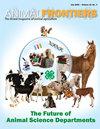Precision livestock farming in egg production
IF 3.2
2区 农林科学
Q1 AGRICULTURE, DAIRY & ANIMAL SCIENCE
引用次数: 11
Abstract
This article focuses on precision livestock farming (PLF) as it pertains to egg production. Specific contents include: (1) an overview of evolution in the egg industry that is reflective of what is now known as PLF and the new trend of egg production, (2) prominent characteristics of modern egg production systems that necessitate further development and adoption of PLF technologies, (3) some examples of PLF tools or technologies for establishment of science-based production guidelines or applications in field operations, and finally (4) outlook of PLF for egg production. For the fundamental principles and elements of PLF, readers can refer to the opening paper by Berckmans (2017) in this issue. Disciplines Agriculture | Bioresource and Agricultural Engineering | Poultry or Avian Science Comments This article is from Animal Frontiers 7 (2017): 24–31, doi:10.2527/af.2017.0105. Posted with permission. This article is available at Iowa State University Digital Repository: http://lib.dr.iastate.edu/abe_eng_pubs/824 Evolution of the Egg Industry Egg production has undergone remarkable advancements over the past six decades. A recent life cycle analysis (LCA) study on the U.S. egg industry, conducted by the Egg Industry Center (Pelletier et al., 2014), revealed drastic reductions of 54–63% in total environmental footprints (greenhouse gases, acidification and eutrophication emissions) from 1960 to 2010. In the meantime, egg supply increased by 30%. These outcomes stemmed from advancements in poultry breeding and genetics, nutrition, disease prevention and control, housing equipment and environmental control, and utilization efficiency in feed and other natural resources as well as increased crop yields. For instance, during the period of 1960– 2010, laying hens in the USA showed a consistent increase of 1.16 extra eggs each year, i.e., 58 extra eggs per hen annually from 1960 to 2010. Feed conversion (FC) (kilogram of feed intake per kilogram of egg output) improved from 3.41 to 1.98 for the same period. Protecting the birds from the influence of seasonal climates has made their productivity much more consistent year-round. An example of maintaining relatively constant indoor temperature despite the largely fluctuating outside weather is illustrated in Figure 1. The same LCA study also identified two “hot spots” that have profound impact on environmental footprints of the operation, namely, feed efficiency and manure management, where further improvements should be focused on. For instance, while FC averaged 1.98, it ranged from 1.8 to 2.2 for the laying-hen flocks surveyed. Clearly, those operations with a poorer FC of 2.2 can particularly benefit from exercising some PLF principles and practices. While the egg industry enjoys these highly commendable advancements and always looks for new ways to provide the population nutritious and affordable protein at unprecedented efficiency, new challenges never stop emerging. Today, concerns over animal welfare or well-being have led to increasing pressure for the industry to develop and adopt alternative egg production systems that better accommodate natural behaviors, thereby, yielding plausibly improved welfare of the animals. Accordingly, new guidelines or regulations concerning how eggs will be produced now and in the future have been established in various parts of the world, predominantly the European Union (EU) and USA. The banning of conventional cage production in the EU as of 1 Jan. 2012 is an example of the movement toward alternative housing systems. The changes in distribution of layer housing styles in EU from 2012 to 2014 are depicted in Figure 2. In the United States, the state of California passed Proposition 2 in 2008 that went into effect 1 Jan. 2015. The law stipulates that all shell eggs sold in California must comply with the rules that include allocation of at least 750 cm2/hen living area (compared with the current industry standard of 432 cm2/hen) when a cage houses at least nine hens, plus the periodic on-farm food safety inspection. To date, more than 100 retailers, grocers, restaurant chains and entertainment companies in USA have pledged to source only cage-free eggs by 2025 or 2030. These pledges amount to more than 72% of the current U.S. national layer inventory that would have to be converted from the present mostly conventional cage production systems (~90%) to cagefree production systems. A recent study conducted through a private-public coalition partnerSrce: © 2016 A dobtock.com Precision livestock farming in egg production Hongwei Xin†‡ and Kai Liu† †Department of Agricultural and Biosystems Engineering, Iowa State University, Ames, Iowa 50014 ‡Egg Industry Center, Iowa State University, Ames, Iowa 50014精准养殖禽蛋生产
这篇文章的重点是精准畜牧业(PLF),因为它涉及到鸡蛋生产。具体内容包括:(1)蛋业的发展概况,反映了现在所谓的PLF和蛋品生产的新趋势;(2)现代蛋品生产系统的突出特点,需要进一步发展和采用PLF技术;(3)一些PLF工具或技术的例子,以建立基于科学的生产指南或在现场操作中的应用;最后(4)PLF对蛋品生产的展望。关于PLF的基本原理和要素,读者可以参考本期Berckmans(2017)的开题论文。本文来自动物前沿7 (2017):24-31,doi:10.2527/af.2017.0105。经许可发布。本文可在爱荷华州立大学数字资源库:http://lib.dr.iastate.edu/abe_eng_pubs/824蛋业的发展在过去的六十年中,蛋品生产经历了显着的进步。蛋业中心(Pelletier et al., 2014)最近对美国蛋业进行的一项生命周期分析(LCA)研究显示,从1960年到2010年,总环境足迹(温室气体、酸化和富营养化排放)大幅减少了54-63%。与此同时,鸡蛋供应量增加了30%。这些成果源于家禽育种和遗传、营养、疾病预防和控制、饲养设备和环境控制、饲料和其他自然资源的利用效率以及作物产量的提高。例如,在1960年至2010年期间,美国的蛋鸡每年增加1.16个额外鸡蛋,即从1960年到2010年,每只母鸡每年增加58个额外鸡蛋。饲料系数(FC)(每千克采食量/每千克产蛋量)同期由3.41提高到1.98。保护鸟类不受季节性气候的影响,使它们的生产力全年更加稳定。图1给出了一个在室外天气波动很大的情况下保持室内温度相对恒定的例子。同一份LCA研究还确定了对养殖业的环境足迹有深远影响的两个“热点”,即饲料效率和粪便管理,应着重于进一步改进。例如,虽然FC平均值为1.98,但在调查的蛋鸡群中,它的范围在1.8到2.2之间。显然,那些FC为2.2的较差的操作可以特别受益于执行一些PLF原则和实践。虽然蛋业享受着这些值得高度赞扬的进步,并一直在寻找新的方法,以前所未有的效率为人们提供营养和负担得起的蛋白质,但新的挑战从未停止出现。今天,对动物福利或福利的关注已经导致行业开发和采用更好地适应自然行为的替代蛋生产系统的压力越来越大,从而产生似乎改善动物福利的可能性。因此,世界各地(主要是欧盟和美国)已经制定了关于现在和未来如何生产鸡蛋的新准则或法规。2012年1月1日起,欧盟禁止生产传统的笼子,这是向替代住房系统发展的一个例子。欧盟2012 - 2014年分层住宅风格分布变化如图2所示。在美国,加利福尼亚州于2008年通过了第2号提案,该提案于2015年1月1日生效。该法律规定,在加州销售的所有带壳鸡蛋必须符合相关规定,包括当一个笼子里至少有9只母鸡时,每只母鸡的生活面积至少为750平方厘米(目前的行业标准为432平方厘米),以及定期的农场食品安全检查。迄今为止,美国已有100多家零售商、杂货店、连锁餐厅和娱乐公司承诺,到2025年或2030年只采购散养鸡蛋。这些承诺的数量超过了美国现有蛋鸡库存的72%,这些蛋鸡将不得不从目前大多数传统的笼式生产系统(约90%)转变为无笼式生产系统。最近的一项研究是通过公私合作伙伴关系进行的。©2016 A dobtock.com精准畜牧业在鸡蛋生产中的应用辛宏伟†与刘凯††爱荷华州立大学农业与生物系统工程系,爱荷华州艾姆斯50014爱荷华州立大学埃姆斯50014蛋业中心
本文章由计算机程序翻译,如有差异,请以英文原文为准。
求助全文
约1分钟内获得全文
求助全文
来源期刊

Animal Frontiers
Veterinary-Food Animals
CiteScore
6.50
自引率
5.60%
发文量
74
期刊介绍:
Animal Frontiers is the official journal of the following globally active professional animal science societies:
ASAS, the American Society of Animal Science
CSAS, the Canadian Society of Animal Science
EAAP, the European Federation of Animal Science
AMSA, the American Meat Science Association
These organizations are dedicated to the advancement and dissemination of science-based knowledge concerning animal agriculture. Animal Frontiers provides a novel forum for innovative and timely perspectives that have relevance to understanding the complex dynamics at work through animal agriculture. Animal Frontiers publishes discussion and position papers that present several international perspectives on the status of high-impact, global issues in animal agriculture. Every issue will explore a theme of broad and current interest within animal science and animal agriculture.
 求助内容:
求助内容: 应助结果提醒方式:
应助结果提醒方式:


